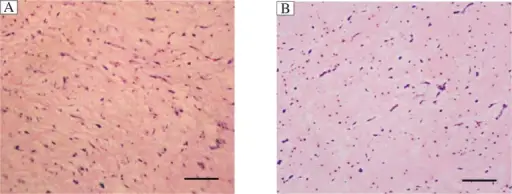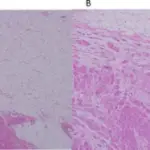Cardiac myxoma is the most common primary heart tumor.
What is the Pathology of Cardiac Myxoma?
The pathology of cardiac myxoma is:
-Etiology: The cause of cardiac myxoma is sporadic with unknown exact cause.
-Genes involved: Abnormality with the short arm of chromosome 2 and chromosome are associated with 7% of all cardiac myxoma cases.
-Pathogenesis: The sequence of events that lead to cardiac myxoma are attributed to a mixture of environmental and genetic factors. It can occur spontaneously with no definite underlying cause.
-Histology: The histology associated with cardiac myxoma shows lepidic cells within the myxoid stroma with structures resembling cords or rings around the blood vessels accompanied by presence of inflammatory cells and hemorrhage with hemosiderin deposits.
How does Cardiac Myxoma Present?
Patients with cardiac myxoma typically affect females more than males and present at the age range of 3-83 years old. The symptoms, features, and clinical findings associated with cardiac myxoma include dyspnea on exertion, fatigue peripheral edema, dizziness/ syncope, and pulmonary edema.
How is Cardiac Myxoma Diagnosed?
Cardiac myxoma is diagnosed depending on its location and size. Generally, a thorough history and physical exam is essential. Blood test, electrocardiogram, chest x-ray, CT scan/ MRI, Echocardiography can be utilized.
How is Cardiac Myxoma Treated?
Cardiac myxoma is treated by removing the tumor.
What is the Prognosis of Cardiac Myxoma?
The prognosis of cardiac myxoma is good due to its benign process, however, 15% of patients with the disease died due to sudden cardiac death.



